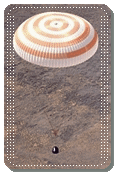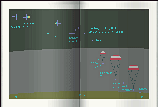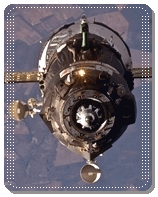
 | a Soyuz-TMA landing, being back from the ISS. picture courtesy NASA/Bill Ingalls |
As, due to the Columbia accident in February 2003, the Russian Soyuz craft had gained a prominent role into ferrying astronauts and cosmonauts to and back of the ISS that role became more prominent still due to that the USA, beginning in 2011, have no more manned vehicle allowing to access to the ISS, as the space shuttles' fleet has been retired and that no new space vehicle have been built. The cost for the US to ride a Soyuz to the ISS is of $63 million per seat. The Soyuz, generally, serves Russia to get to, or come back from, the ISS. One Soyuz is always usually docked at the station. It's used as the ISS crew usual return craft as it serves too as a rescue craft in case of emergency. A new Soyuz is ferried to the ISS each six months -the duration a Soyuz can stay healthy at the ISS- and the one which was docked is used by an outgoing crew. U.S. and Russian cosmonauts bound to a flight to the ISS are training at the Gagarin Cosmonaut Training Center in Star City, Russia as they launch from the Baikonur Cosmodrome in Kazakhstan. A Soyuz needs about a tow-day ride to the ISS
The first Soyuz spacecraft flew in 1967 as it was originally designed to take cosmonauts to the Moon. The Soyuz TMA is an improved version of the Soyuz TM, which was used between 1986 and 2002. A Soyuz is composed of three modules. An Orbital Module. It is the front sphere where crew is during the orbital flights and for docking. The Descent Module which is the center module where the crew is for takeoff and descents. It's the only part of the craft which returns Earth. At last the Instrumentation/Propulsion Module, which is the rear module. It contains the instruments and the main propulsion system used for orbital and docking-undocking maneuvers. Soyuz have little changed since one craft carried Yuri Gagarin in orbit in 1961 as the Russian Roskosmos agency boasts the reliability and cost efficiency of their spacecraft, further saying that its design is constantly being modernized
 | click for a sketch illustrating the descent phases of a Soyuz TMA |
A Soyuz re-entry is lasting 3.5 hours. The crew enters the Soyuz some time -up to 3 hours- before undocking. At undocking time (landing minus 3h 23) the maneuver begins. Latches are beginning to be released. Latches are released at undocking plus 3 mn as springs are pushing the Soyuz back from the ISS (at 4 inches per second). At undocking +6 mn the Soyuz -which is at 66 feet from Space Station- performs a manual 15-second separation burn. At undocking +2h 29 mn (landing -54 mn; the craft is 12 miles from the ISS), the Soyuz performs a deorbit burn. The burn lasts 4 mn 21 s. The deorbit burn slows the craft. Hence the craft begins its descent. After the deorbit burn, the Orbital and Instrumentation/Propulsion Modules are separated from the Descent Module at about 87 miles of altitude. They are burning at their re-entry. At undocking +2h 57 mn (landing -26 mn, deorbit burn +31 mn), the Descent Module is reaching the Entry level (400,000 ft) and endures the usual phase of atmospheric heating and ionization (loss of any radio communications) due to its taking contact back with the denser layers of the atmosphere. The first part of the descent into the atmosphere is still controlled through its guidance, navigation, control systems, and thrusters as, when radio contact is recovered with the Earth, the descent keeps ballistic only
At landing -15 mn (undocking +3h 08 mn), a series of parachutes opens. Two pilot parachutes open first, as the second one extracts the "drogue chute". The drogue chute is lowering the descent rate from 755 ft to 262 ft per second. The main parachute further lowers the craft to 24 ft per second. This second parachute is hanging the Soyuz to an angle of 30°. This is to dissipate heat. The angle is cancelled then. At just 2.6 ft above the ground -just two seconds before landing- six landing rocket engines are ignited slowing the craft down to a mere 5 ft per second. For the undocking operations the ISS is descending to a specified altitude and then climbs back to its duty altitude, using the engine of the docked Progress cargo. Debris from the atmospheric portion of the descent are found up to 515 miles ahead from the landing area
 | a Soyuz-TMA detail. picture courtesy NASA |
It's the Flight Command Center, Moscow, Russia, which manages the re-entry of the Soyuzs. A Navigation Center is situated in Arkalyk and a Control Center in Zheskasgan, Kazakhstan. The precise landing coordinates are communicated by the Command Center to a recovery mission team, equipped with specialized vehicles. Zheskasgan, Kazakhstan, may be considered the official Soyuz vehicle-landing site since the 1960s. The land-based operations are joined by helicopters too. The recovery team acquires the short- and ultra- shortwave radio signal of the Soyuz capsule, allowing to head to the actual landing site. Once the Soyuz landed, the recovery team sets up a security perimeter and then opens the hatch. The Soyuz usually initially lands upright before being tilted on its side for servicing. When US astronauts are aboard, NASA officials are present for the landing, sending a report on the condition of the crew members to NASA headquarters. Medical doctors are watching over cosmonauts and/or astronauts as they readapt to Earth gravity in reclining chairs. Russian Kentaur are protective suits are worn by a Soyuz crew during reentry into Earthís atmosphere. The anti-gravity suits prevent blood from pooling in a crew memberís legs helping facilitate the adjustment to gravity. They the crew boards helicopters which fly them to the Karaganda air base, in Kustanai, Kazakhstan . Then, further, the crewmembers are flown back to the Gagarin Cosmonaut Training Center in Star City, Russia, where they reunite with family and friends and perform debriefings and medical activities. In case of US astronauts, things are the same, as they then travel back to Houston for further post-flight activities. In 2014, ESA has his one of his astronauts to return directly to Europe for rehabilitation in Cologne, Germany for the first team as a ESA team of doctors and physiotherapists at the German Aerospace Centerís 'envihab' facility, next door to ESAís European Astronaut Centre managed that
Accidentally, a Soyuz ship launch to the ISS may be seen like unfolding according to the hollowing schedule:
9:20 a.m. Crew departs Cosmonaut Hotel
9:35 a.m. Batteries installed in booster
10:05 a.m. Crew arrives at Site 254
10:20 a.m. Tanking begins
10:50 a.m. Crew suit up
11:15 a.m. Booster loaded with liquid oxygen
11:50 a.m. Crew meets family members on other side of the glass
12:15 p.m. First and second stage oxygen fueling complete
12:20 p.m. Crew walkout from 254; boards bus for the launch pad
12:25 p.m. Crew departs for launch pad at Site 31
12:45 p.m. Crew arrives at launch pad
12:55 p.m. Crew boards Soyuz; strapped in to the Descent module
1:45 p.m. Descent module hardware tested
2:00 p.m. Hatch closed; leak checks begin
2:20 p.m. Launch vehicle control system prep; gyro activation
2:35 p.m. Pad service structure components lowered
2:36 p.m. Clamshell gantry service towers retracted
2:43 p.m. Suit leak checks begin; descent module testing complete
2:46 p.m. Emergency escape system armed
3:05 p.m. Suit leak checks complete; escape system to auto
3:10 p.m. Gyros in flight readiness and recorders activated
3:13 p.m. Pre-launch operations complete
3:14 p.m. Launch countdown operations to auto; vehicle ready
3:15 p.m. Commanderís controls activated
3:16 p.m. Combustion chamber nitrogen purge
3:17 p.m. Propellant drainback
3:17 p.m. Booster propellant tank pressurization
3:18 p.m. Ground propellant feed terminated
3:19 p.m. Vehicle to internal power
3:19 p.m. First umbilical tower separates
Auto sequence start
3:19 p.m. Ground umbilical to third stage disconnected
3:19 p.m. Second umbilical tower separates
3:20 p.m. Launch command issued
Engine Start Sequence Begins
3:20 p.m. Engine turbopumps at flight speed
3:20 p.m. Engines at maximum thrust
3:20:13 p.m. LAUNCH
3:28 p.m. Third stage separation and orbital insertion
After launch, a Soyuz usually takes about 2 days to reach to the ISS as recent choice have reduced that time to 6 hours only
Website Manager: G. Guichard, site 'Amateur Astronomy,' http://stars5.6te.net. Page Editor: G. Guichard. last edited: 6/4/2018. contact us at ggwebsites@outlook.com